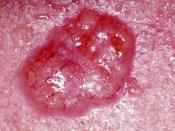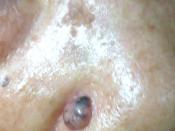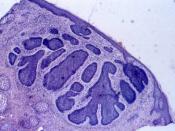Skin Cancer
Every hour one American is killed by skin cancer and every thirty
seconds one American gets skin cancer. Cancer is a deadly disease that
alters the DNA of a skin cell and causes it to reproduce at a rapid pace.
This overproduction of cells can be harmful and in many cases deadly.
Many steps have been made in the treatment of Basal Cell Carcinoma,
some have been successful. The cells that have altered DNA are called
malignant or cancerous cells. These cells are found in the outer layers
of the skin. The skin's main job is to protect the body from infections
and to insulate the body to keep it at the proper temperature. The first
layer of skin is called the epidermis. This is the layer that is closest to
the surface of the skin. There are three types of cells in this layer. The
first is the squamace.
The squamace cells are flat and scaly and are
located closest to the surface of the skin. Second are the basal cells and
finally are the melanocytes, which give the skin its color. The second
layer of skin is the dermis, which is much thicker than the epidermis.
This layer contains sweat glands, nerves and blood vessels. The dermis
also contains follicles, which are tiny pockets from which the hair
grows. The most common malignant cells are the basal cells. Cancer in
the basal cell is called nonmelanoma cancer. Basal Cell Carcinoma is
caused by overexposure to the sun. The sun gives off ultraviolet rays,
which are harmful to the human body. Basal cell carcinoma will affect
body parts such as the eyes, ears and nose. If it is detected before it
gets deep into the skin there will most likely be no problem treating the
cancer. A problem will occur if it isn't detected quickly enough. if Basal
cell carcinoma is left untreated it can be very hard to treat and may
cause death. Mohs micrographic surgery, a newer surgical technique,
has the highest cure rate for surgical treatment of both primary and
recurrent tumors. This method uses microscopic control to determine
the extent of tumor invasion. Although Mohs micrographic surgery
method is complicated and requires special training, it has the highest
cure rate of all surgical treatments because the tumor is outlined until
it is completely removed. While other treatment methods for recurrent
basal cell carcinoma have failure rates of about 50%, cure rates have
been reported at 96% when treated by Mohs micrographic surgery. It
has been found that 36% of patients who develop a basal cell carcinoma
will develop a second primary basal cell carcinoma within the next five
years Basal cell carcinoma is 100% preventable with the daily use of
sunscreen beginning in the childhood years. Sunscreen prevents the
ultraviolet rays from coming in contact with the skin thus preventing
the cancer from entering into you body. Cancer is a killing disease that
needs to become preventable.



Skin Cancer
its an ok essay. but ur ideas are incomplete and its short. unless your in a small grade i dout it being 97%
2 out of 2 people found this comment useful.